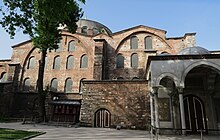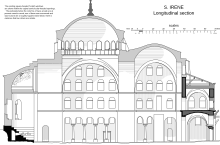User:Rylienicolee/Assignment sandbox
Byzantine Architecture[edit]
Byzantine architecture is the architecture of the Byzantine Empire, also known as the Later Roman or Eastern Roman Empire. Byzantine architecture was mostly influenced by Roman and Greek architecture. It began with Constantine the Great when he rebuilt the city of Byzantium and named it Constantinople and continued with his building of churches and the forum of Constantine. This terminology is used by modern historians to designate the medieval Roman Empire as it evolved as a distinct artistic and cultural entity centered on the new capital of Constantinople rather than the city of Rome and environs. The empire endured for more than a millennium. Its architecture dramatically influenced the later medieval architecture throughout Europe and the Near East, and became the primary progenitor of the Renaissance and Ottoman architectural traditions that followed its collapse.
Hagia Irene[edit]

One of the less famous Byzantine churches is Hagia Irene. This church served as a model church for the more famous church, Hagia Sophia. Construction on the church began in the 4th century. This was the first church that was built in Constantinople, but due to its location, it was severely damaged by earthquakes and the Nika riots, and required repair several times. The Hagia Irene is defined by its large atrium, and is in fact the only surviving building of the Byzantine Empire to have such a feature[1].
Construction of Hagia Irene[edit]
Hagia Irene is composed mainly of three materials: stone, brick, and mortar. Bricks 70 cm x 35 cm x 5 cm were used, and these bricks were glued together using mortar approximately 5 cm thick. The building materials chosen for construction of the church had to be lightweight, durable, and strong. Volcanic materials were chosen for this purpose, as volcanic concrete is very light and durable. Perhaps the most definite feature of the Hagia Irene is the strict contrast between the interior and exterior design. While the plain outside composed of stone and brick favors functionality, the interior is decorated in elaborate mosaics, decorative marble, and, in some places, covered in plaster. Another important characteristic of the church include two domes that follow one behind another, the first being a lower oval, and the second being a higher semi-circle[1].

History of Hagia Irene[edit]
Throughout history Hagia Irene has undergone several changes. There were multiple repairs due to the Nika riots and earthquakes. When the Ottomans took over Hagia Irene they repurposed it and made a few changes, but none as drastic as what was done to Hagia Sophia[1]. Today, Hagia Irene is still standing and open to vistors as a museum. It is open everyday, except for Tuesdays[2].
| Time | Event |
|---|---|
| 4th C. | Construction Began |
| 532 | Church was burned during Nika revolt |
| 548 | Emperor Justinian repaired the church |
| 740 | Significant damages from earthquakes |
| 1453 | Constantinople was conquered by the Ottomans - became a weapons storehouse |
| 1700 | Became a museum |
| 1908-1978 | Served as a military museum |
Hagia Sophia[edit]
The most famous example of Byzantine architecture is Hagia Sophia. The Hagia Sophia held the title of largest church in the world until the Ottoman Empire sieged the Byzantine capital. After the fall of Constantinople, the church was converted into a mosque and was used for religious services until 1931, until it was reopened as a museum in 1935.Translated from Greek, the name Hagia Sophia means "Sacred Wisdom"[3].
Construction of Hagia Sophia[edit]
The construction is a combination of longitudinal and central structures. This church was apart of a larger complex of buildings created by Emperor Justinian. This style influenced the construction of several other buildings, such as St. Peter's cathedral. Hagia Sophia should have been built to withstand earthquakes, but since the construction of Hagia Sophia was rushed this technology was not implemented in the design, which is why the building has had to be repaired so many times due to damages from the earthquakes. The dome is the key feature of Hagia Sophia as the domed basilica is representative of Byzantine architecture. Both of the domes collapsed at different times throughout history due to earthquakes and had to be rebuilt[4].
History of Hagia Sophia[edit]
The original construction of Hagia Sophia was ordered by Emperor Constatine I in 360. His building of churches, specifically Hagia Sophia, was considered an incredibly significant component in his shift of the centralization of power from Rome in the East to Constantinople in the West, and was considered the high-point of religious and political celebration. The construction of the final version of Hagia Sophia, which still stands today, was overseen by Emperor Justinian. Between the rule of these two Emperors, Hagia Sophia was destroyed and rebuilt twice. Following its reconstruction, Hagia Sophia was considered the center of Orthodox Christianity for 900 years, until the conquest of Constantinople by the Ottomans[5].
| Time | Event |
|---|---|
| 360 | Construction began |
| 404 | Hagia Sophia was burned down in public riot. |
| 415 | Construction begins on the second version of Hagia Sophia. |
| 532 | The church is once again demolished during Nika revolts. |
| 537 | The final version of Hagia Sophia opens to worship after five years of construction. |
| 1453 | Constantinople is concurred by the Ottomans. |
| 1935 | Hagia Sophia is converted into a museum . |
References[edit]
- ^ a b c d "The Unique Construction of the Church of Hagia Irene in Istanbul for The Teaching of Byzantine Architecture". Procedia Engineering. 161: 1745–1750. 2016-01-01. doi:10.1016/j.proeng.2016.08.770. ISSN 1877-7058.
- ^ "Hagia Irene Museum Opened | Topkapı Palace Museum Official Web Site". topkapisarayi.gov.tr. Retrieved 2018-11-21.
- ^ Bordewich, Fergus M. "A Monumental Struggle to Preserve Hagia Sophia". Smithsonian. Retrieved 2018-11-22.
- ^ Plachy, Jan; Musilek, Josef; Podolka, Lubos; Karkova, Monika (2016). [file:///C:/Users/mrhov/Downloads/Disorders_of_the_Building_and_its_Remediation_-_Ha.pdf "Disorders of the Building and Its Remediation - Hagia Sophia, Turkey The Most the Byzantine Building"] (PDF). Procedia Engineering. 161: 2259–2264.
{{cite journal}}: Check|url=value (help) - ^ Cohen, Andrew (2011). "Architecture in Religion: The History of the Hagia Sophia and Proposals For Returning It To Worship". FIU Electronic Theses and Dissertations. DOI: 10.25148/etd.FI14060867: 2–3.
- ^ "Ayasofya Müzesi |". ayasofyamuzesi.gov.tr (in Turkish). Retrieved 2018-11-22.
